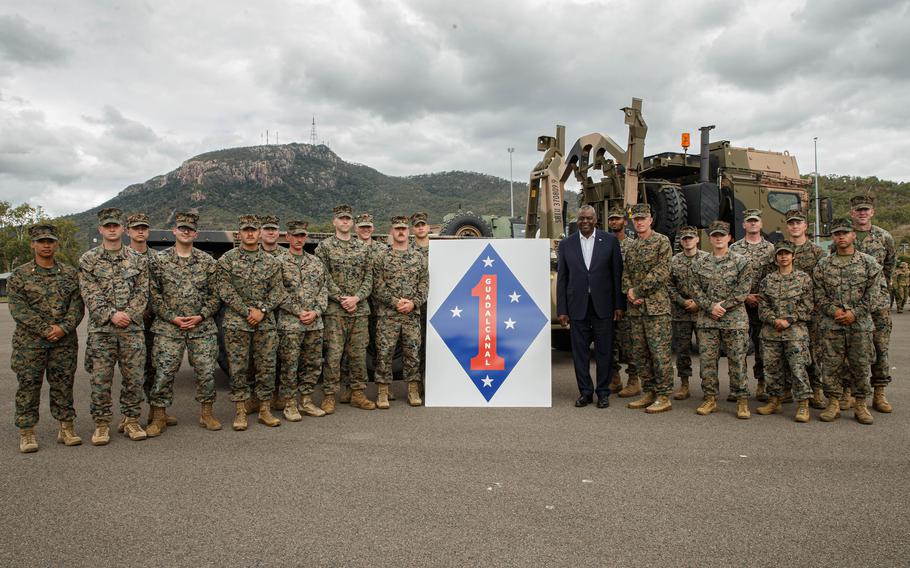
U.S. Secretary of Defense Lloyd J. Austin III and U.S. Marines with 1st Marine Division pose for a photo during Exercise Talisman Sabre 23 at Lavarack Barracks in Townsville, Australia, July 30, 2023. Talisman Sabre is the largest bilateral military exercise between Australia and the United States. (Emeline Molla/U.S. Marine Corps)
The visit to Australia by U.S. Secretary of State Antony Blinken and Defense Secretary Lloyd Austin in late July was important and deserved more attention than it received. They met with their Australian counterparts in Brisbane for focused talks on defense and related matters.
Australia, geographically distant, is increasingly central in the growing, multifaceted contest with China. The visit follows on the significant, but also little noticed, U.S. decision last year to deploy up to six B-52 strategic bombers to Northern Australia. This imposing, and enormously capable, long-range strategic bomber is one of the most durable and respected military aircraft in history. In 2011, Prime Minister Julia Gillard announced an agreement to station U.S. Marines in that country.
China represents an important, growing challenge to both nations.
The United States opposes China’s access to disputed reefs and islands in the South China Sea. Beijing is an aggressively expanding presence in the area. China has protested the deployment of B-52s and other U.S. moves.
In this tense context, Australia remains a vital U.S. ally. ANZUS, the Australia-New Zealand-U.S. security alliance, was dramatically reenergized by the terrorist attacks of 9/11. Australians were targets in the 2002 terrorist bombings on the Indonesian island of Bali. In 2004, the Australian Embassy in Jakarta, Indonesia, was attacked.
The American-Australian special relationship was forged in the crucible of World War II. In that war, the enormous Japanese military drive south was finally blunted just short of Australia. Knowledgeable jungle-savvy Australian troops provided vital support to generally inexperienced Americans.
The Vietnam War led to strengthening the Australia-United States partnership even while straining U.S. relations with Britain and other allies. A total of 50,000 Australian military personnel served in Vietnam; 520 were killed and 2,400 wounded. Reflecting these pressures, Australia reintroduced military conscription in 1964.
In October 1966, Lyndon B. Johnson became the first U.S. president to visit Australia, underscoring cooperation with Prime Minister Harold Holt. This characteristically dramatic LBJ expedition was undertaken to cast the Vietnam War in global terms.
Australian forces gained valuable guerrilla war experience during the Malaya Emergency from 1948 to 1960 fighting the Malayan National Liberation Army. The communist insurgency was finally suppressed, confirming the value of patience in employing sustained, carefully directed military force.
President Richard M. Nixon and national security adviser Henry Kissinger tried to apply Malaya insights to Vietnam. Sir Robert Thompson, a highly respected British guerrilla warfare expert, was consulted and provided encouraging estimates of the prospects of the South Vietnamese military.
Gen. Creighton Abrams, after succeeding Gen. William Westmoreland as Vietnam commander, redirected U.S. forces away from massive search-and-destroy operations to small unit actions, reflecting the strategy successfully employed in Malaya. The war strengthened ties especially between Australia and the U.S. among military professionals.
The Afghanistan insurgency was somewhat similar to Malaya and Vietnam. David Kilcullen, a retired Australian army officer, is influential in American security circles. Australians also do humanitarian work in Pakistan and elsewhere.
Australia provides bridges between developed and developing nations, reflecting historical legacies as well as geography. Rather ironically, the nation’s economy is greatly aided by proximity to China.
In September 2021, Australia, the United Kingdom and the United States announced the new AUKUS partnership. Britain, following departure from the European Union, signed a free trade agreement with Australia in December 2021. The reinvigorated Quadrilateral Security Dialogue (QUAD) among Australia, India, Japan and the U.S. is another example.
The steady rise of China in economic and military terms, combined with growing assertiveness abroad, especially in the immediate region, gives high priority to Pacific security planning and force profiles. The visit by the two U.S. Cabinet officials symbolizes this.
Australia, Britain and the United States comprise a strong triangle.
Arthur I. Cyr is author of “After the Cold War.”